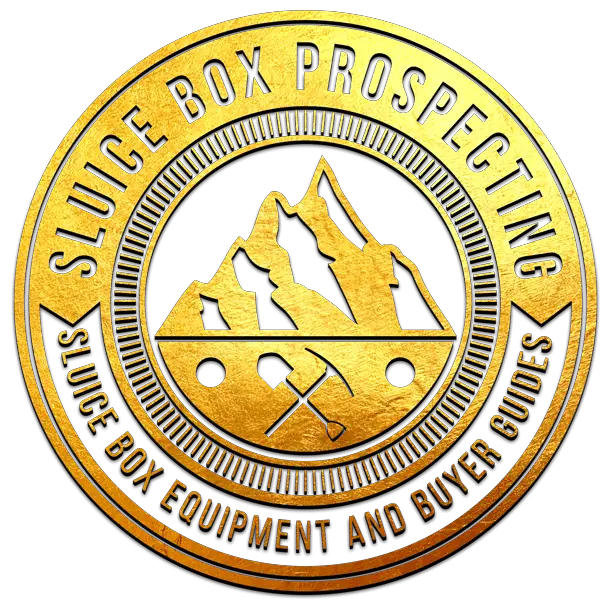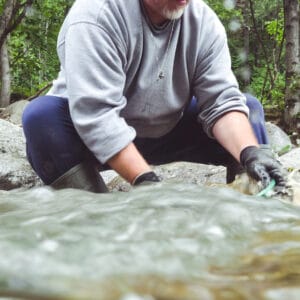Although it is rare, there are occasions where you’re out prospecting or simply wandering a terrain and discover the perfect location to pan for gold or other finds. However, if you don’t have a pan on hand, you might deem this an opportunity wasted. We’re here to show you that it’s still possible to go prospecting without a pan when using the right gold pan alternatives.
With our step-by-step guide and insightful tips listed below, you too can prospect to your heart’s desire without carrying around a pan. We’ll also discuss the pros and cons of foregoing the classic prospecting pan for these alternative methods so you can decide which tool is ultimately best for your prospecting success.
How To Pan For Gold Without A Pan: 3 Tips To Help You Succeed
Table of Contents
1. Choose The Right Gold Pan Alternative
One of the trademark tools of a prospector is their pan, which they use for sampling sediment before setting up equipment and for extracting and collecting gold or desirable rocks and minerals. Prospectors have been using pans for hundreds of years, but they aren’t the only tools you can use for this process.
If you forget your prospecting pan or willingly leave it behind, you can opt for one of several common alternatives.
11 Effective Gold Pan Alternatives:
- Tupperware containers
- Bowls
- Batea
- Dulang
- Lortok
- Yuri-ita
- Buckets
- Bottles
- A large spoon
- Small plastic tubs
- Hats
In our opinion, the objects listed above can be divided into three different categories depending on your needs and the reason you lack a prospecting pan. Alternatively, you can use these items for initial panning and then remove additional black sand concentrates elsewhere when you have the proper tools.
Worst-Case Scenario Prospecting Pan Alternatives
Forgetting a prospecting pan can quickly turn a promising outing into a bleak occasion, but it doesn’t have to be a complete waste. Many people have been able to walk home with gold or other precious finds using what they had on hand or at home/camp.
These are what we deem “worst-case scenario” alternatives to your prospecting pan and include items such as hats, large spoons, or plastic bottles (preferably the top portion of a 2 liter or an average water bottle).
Items like these might be accessible but truly aren’t ideal for the process. However, if they have the right characteristics, they could work as long as you use proper technique, remain determined, and curb your expectations.
Legitimate Prospecting Pan Alternatives
While prospecting pans are a trade favorite for their design and functionality, some legitimate alternatives will arguably work just as well. These are the ideal items to grab when you don’t have a pan or replace the pan entirely if you prefer not to use one or can’t afford to purchase a prospecting pan yet.
Legitimate prospecting pan alternatives include Tupperware containers, bowls, buckets that are voluminous, shallow, and easy to handle. Many people will also use small plastic tubs measuring about 2 ft in diameter and about 1 ft deep. Although this is much larger than your typical gold pan, it is a favored choice in many regions, particularly Mongolia.
Cultural Prospecting Pan Alternatives
Prospecting and panning for gold isn’t just an American practice. Peoples worldwide enjoy partaking in this activity in search of precious materials, and they each have their own take on the classic pan.
If you’re getting sick of prospecting pans and want to find an alternative that works just as well, consider opting for a cultural alternative like the ones listed below.
| Pan alternative name | Origin | Description |
| Batea | South Africa | A large wooden bowl designed and used primarily for prospecting |
| Dulang | Asia | A conical wooden bowl similar to the batea and pan |
| Lortok | Russia | An angled rectangular tray typically made of wood with raised edges and one corner open for funneling |
| Yuri-ita | Japan | Also known as a rocking tray, this item is similar to the lortok in that it is a wooden, rectangular tray with a concave cross-section and a seal or ridge located on one end |
All of these items have been used for nearly as long, if not longer, than the American version of the prospecting pan and would work wonders as a viable alternative.
2. Ensure Your Gold Pan Alternatives Have the Right Characteristics
If you don’t have any of these items on hand, you could still potentially find a decent pan alternative as long as the object has the criteria listed below.
If you want your prospecting pan alternative to having even a hope of success, it shares many of the original pan’s characteristics, namely being:
- Water-resistant
- Shallow
- Light
- Easy to grip
- Voluminous
Without these characteristics, you’ll find it extremely difficult to conduct proper panning techniques, and you’re more likely to spend fruitless time on this endeavor.
If you’re ready to buy a gold pan, or at least review which pan is right for you, check out the post: Top 5 Best Gold Pan Options With Reviews And Buying Guide.
Now, let’s briefly discuss the importance of each gold pan characteristic, so you have a better idea of what to look for in a pan alternative should the need arise.
Water-resistant
It’s no secret that any tool you use for panning will get wet at some point. While dry panning does exist, it isn’t a common method prospectors use. Therefore, for your pan alternative to function properly and withstand the significant amount of water exposure necessary for this process, it’s going to have to be at least water-resistant, if not waterproof.
Shallow
Although this isn’t the most vital characteristic on the list, it’s certainly helpful for a prospector’s panning technique. A shallow tool will make panning easier. It will allow sediment and other undesirable materials to flow out of the tool while reducing the risk of all sediment flooding out at once.
Light
Panning is a physically demanding job that requires you to shake, swirl, and repeatedly dunk the tool in the water. If you have a heavy panning tool, you’re going to tire easily, especially when you consider how heavy streambed material is on its own. You also don’t want to be carrying around a heavy panning tool when searching for ideal locations.
Easy to grip
In addition to being light, you’re going to want your tool to be easy to grip so you can confidently hold on to your panning tool throughout the several minutes it takes to perform this process. Again, streambed material can be quite heavy, so having an easy-to-grip tool will help you bear the weight and easily maneuver the tool.
Voluminous
The more material you can fit into the pan at once while still performing proper panning techniques, the better. Therefore, while it’s true you want a shallow tool, you also want one that’s decently sized so you can increase your loads and process more material at once. This will increase your odds of finding gold or other precious stones and minerals.
3. Use Proper Gold Panning Techniques
Anyone could feasibly go prospecting and pan for gold without an actual pan tool. Still, their success level while using one of these gold pan alternatives depends on their experience and panning technique.
The basics of panning are:
- Fill your pan ¾ full of material
- Submerge it just to the top in water
- Shake the pan vigorously from side to side to start working out material
- Pick out giant rocks
- Continue to wash out material by moving the pan in a circular motion (keep the tool’s lid level with the water for this)
- Wash out any black sand
- Collect remaining gold
Of course, it looks easy listed in seven small steps, but the process itself takes significant time and practice. But this is the process you will always use for panning regardless of which tool you’re using.
In the end, your tool isn’t going to do very much for you if you don’t know how to pan for gold properly. This is a skill prospectors have to learn and takes time to perfect. Even if you use the best pan possible, you’ll have minimal success if it isn’t supplemented with the fundamentals of panning.
We suggest working on your technique first using a $10 prospecting pan and then transferring this knowledge to alternatives when necessary. The techniques you would use are the same; the tool has just changed.
Final Thoughts
The next time you find yourself by a body of water that’s perfect for panning but discover you don’t have your pan with you, don’t head for home just yet. You can use a wide range of pan alternatives for prospecting, many of which can be found at home, in your car, or even in your traveling bag.
While some are better than others, we always recommend giving these alternatives a shot in a pinch. You’d be surprised how much gold you can still find using something as simple as a water bottle or Tupperware container.
Gold Pan Alternative Sources:
http://nevada-outback-gems.com/design_plans/DIY_pan/gold_pan.htm
https://www.youtube.com/watch?v=_rLyWrYHJ1E&t=133s
https://www.silverrecyclers.com/blog/how-to-make-a-gold-pan.aspx
https://www.prospectingplanet.com/can-you-pan-for-gold-without-a-pan/


